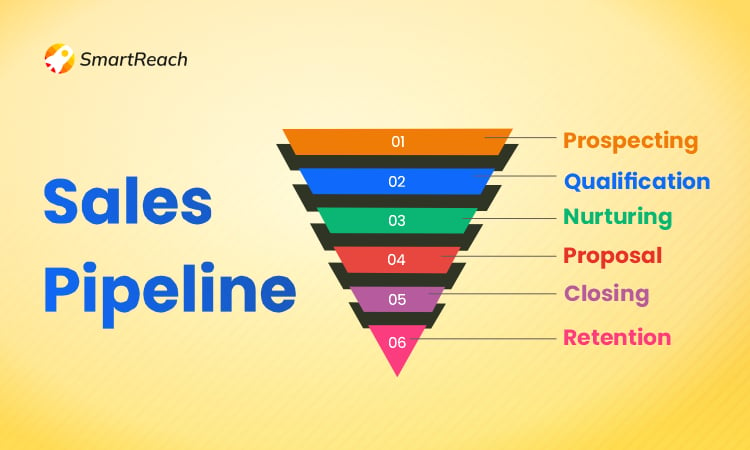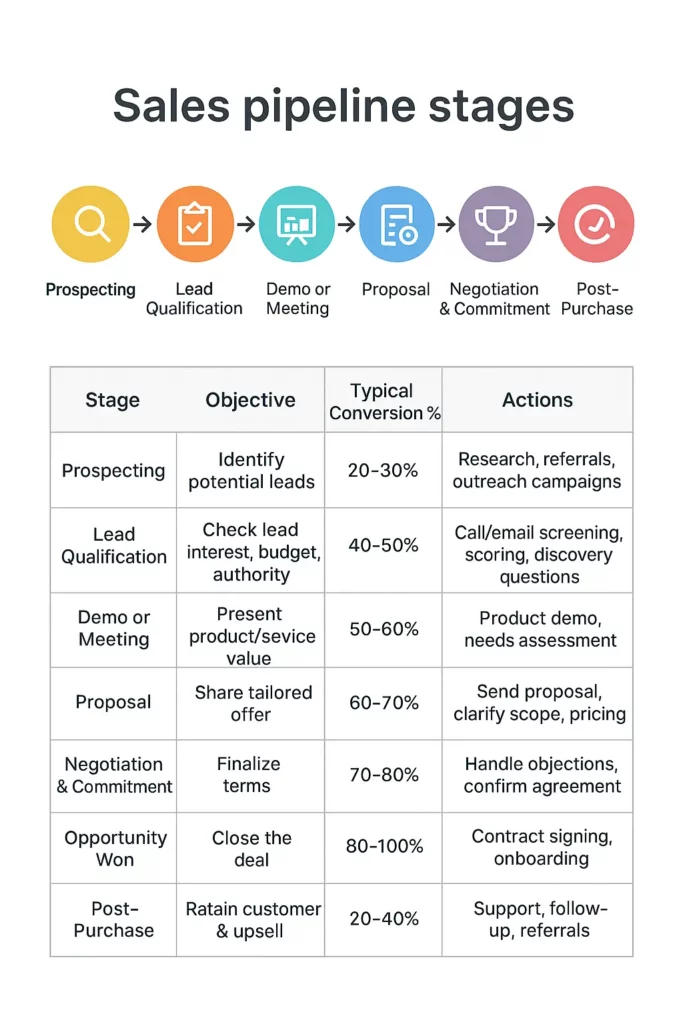Sales Pipeline
Back to Glossary
TL;DR
Q. What is a sales pipeline?
Ans. A sales pipeline is a visual map of where prospects are in your sales process from lead to close. Typical stages: Prospecting → Qualification → Proposal → Close.

A good sales pipeline is important for increasing sales and forming strong customer relationships. It is a critical component for a business that can increase its profits by 28%.
The key to winning in sales is having a healthy pipeline and nurturing every step of the journey.
– Jill Konrath
The term ‘sales pipeline’ is commonly used in sales discussions. If you are in sales, you’ll often hear phrases like “adding prospects/leads to the sales pipeline,” “growing your sales pipeline,” and “filling the sales pipeline with promising leads.”
You might be aware of all these. If you are not, then this article will explain the basics of the sales pipeline. So let’s get started.
What is a sales pipeline?
A sales pipeline is a visual representation of the steps prospects take from first contact to becoming paying customers. It helps sales teams monitor deals, prioritize leads, and predict revenue accurately.
Sales pipelines give a clear overview of all active opportunities, enabling teams to identify bottlenecks, forecast outcomes, and allocate resources efficiently.
Sales pipeline meaning
The sales pipeline represents the structured journey that potential customers follow from initial awareness to final purchase. It provides businesses with a systematic way to manage prospects, track progress, and improve sales performance.
A well-defined sales pipeline ensures that no leads are neglected and helps in setting realistic sales targets while optimizing the overall sales process.
What are the sales pipeline stages?
A typical sales pipeline consists of several key stages that guide a prospect from lead to customer. These stages are:
- Prospecting
- Lead qualification
- Demo or meeting
- Proposal
- Negotiation and commitment
- Opportunity won
- Post-purchase

*sales pipeline stages with detailed analysis for each stage
Detailed explanation of each sales pipeline stage:
Step 1) Prospecting – Finding potential customers through research, referrals, or marketing.
Step 2) Lead qualification – Checking if the lead is interested, has the budget, and can make a decision.
Step 3) Demo or Meeting – Showing the product or service and addressing the lead’s needs.
Step 4) Proposal – Presenting a clear offer with pricing and benefits.
Step 5) Negotiation and Commitment – Agreeing on terms and resolving objections.
Step 6) Opportunity Won – Closing the deal and converting the lead into a customer.
Step 7) Post-Purchase – Supporting the customer and exploring upsell or referral opportunities.
Read more: What is a Sales Pipeline? 7 Stages & Why You Must Track It
Why is the sales pipeline important?
A sales pipeline is crucial for many reasons that impact both the efficiency and effectiveness of your sales team and the overall health of your business.
Clearer visibility of deal progress
The sales pipeline gives you a clearer picture of where your prospects stand in their sales journey. This transparency helps you to identify hot leads, prioritize your efforts where required, and avoid wasting your time on dead ends.
Accurate sales forecasting
When you start analyzing the numbers and the stage at which your leads are currently standing, you can predict your revenue more accurately. With this prediction, you can allocate your resources accordingly, set budgets, and also set realistic goals.
Streamline process
When you have the sales pipeline well-defined, it breaks down the sales process into distinct, manageable stages. This ensures consistency, reduces confusion, and allows reps to focus on specific tasks at each stage.
Performance tracking
You can monitor individual and team performance with the help of a sales pipeline. This enables the identification of top performers, areas for improvement, and adjustment of strategies.
Our blog on sales pipeline covers the points along with use cases and examples in detail. It also provides a much more detailed explanation.
How to build a sales pipeline from scratch? (step-by-step)
Building a successful sales pipeline requires careful planning and execution. Here’s a step-by-step guide to get you started:
Step 1) Define your ideal customer profile (ICP)
First, have a clear understanding of who your ideal customer is. Get all the information on demographics, needs, challenges, and buying behaviors. When you have a clear ICP, it helps with precise targeting and customizes your pipeline accordingly.
Step 2) Map your sales cycle
Now outline the specific stages your leads go through before becoming customers. This could include prospecting, qualifying, nurturing, proposals, negotiations, closing, and post-sale support.
Keep track of the time spent in each stage and if there are any potential bottlenecks.
Step 3) Define clear criteria for each stage
Next, you have to establish specific criteria for moving leads from one stage to another.
This process would make sure that consistency is maintained and would prevent any kind of confusion for your sales team.
Step 4) Choose a CRM system
A CRM can help you keep track of your lead information., manage tasks and analyze pipeline data. This is optional, but using a CRM would help in maintaining your lead data.
Make sure to choose a CRM that aligns with your budget, team size, and desired functionalities.
Step 5) Develop lead generation strategies
First, identify the channels by which you want to reach your leads.
Run an experiment & track the channels you are using to reach your leads and identify which works out the best and which needs improvement. Accordingly, make changes to your lead generation strategies.
Don’t know how to formulate a B2B lead generation strategy?
Here’s a quick guide for you: B2B Lead Generation Strategies For Sales Teams
Step 6) Define sales activities for each stage
Now make a specific list of tasks that your sales team needs to perform in each stage to move the leads to the next stage. This could include calls, emails, meetings, presentations, etc.
Make sure that the activities are aligned with the lead’s current stage and their specific needs.
Step 7) Set pipeline goals and track progress
Set clear objectives for your sales pipeline, such as lead generation, conversion rate, and pipeline value.
With the help of CRM, you can regularly track your pipeline progress and adjust your strategies as needed.
Step 8) Monitor and Analyze Metrics
Regularly track and analyze key metrics such as conversion rates, sales cycle length, deal size, etc. Identify areas for improvement and make changes to your sales pipeline based on data insights.
How to maintain a healthy sales pipeline?
Maintaining a healthy and productive sales pipeline requires consistent effort and attention. Here are some key tips you can follow to keep your sales pipeline flowing:
1. Regularly update your prospect’s data
You should keep a fixed time frame where you review your sales pipeline and remove the leads that don’t have any kind of activity or engagement in a while. There is very little or no chance of these leads converting, but instead, they would clog your pipeline.
Also, you should ensure all your leads’s information is accurate and up-to-date. Outdated information can lead to a waste of your time and effort and missed opportunities.
You should also make it a practice to classify your leads on their potential value and the likelihood of conversion rather than mixing all your lead data together. Accordingly, focus your attention on higher-priority leads.
2. Consistent activity and engagement
Make sure that your leads don’t stagnate at a single stage. If they don’t respond the 1st time, schedule regular follow-ups for each stage and try to push them smoothly down the funnel.
Making your communications personalized and sharing informative content and relevant offers can help keep them engaged.
To maintain consistent communication with your prospects, you can use a sales engagement platform like SmartReach.io, where you can automate the entire communication sequence with your prospects.
Here’s how SmartReach.io works ⤵️
It’s free to use and doesn’t require a credit card at the sign-up.
You can try almost all the SmartReach.io features to reach out to your potential customers at scale.
Try SmartReach.io for FREE. (Sign-up link added 🎁)
3. Analyze and optimize
Keep track of your key metrics at a regular interval. You can track conversion rates, sales cycle length, average deal size, and other relevant metrics. This will help you to get an idea of how your sales pipeline is performing.
Once you start analyzing your metrics, you will get a clear idea of where your leads are getting stuck and what is stopping them from progressing. Accordingly, optimize your sales pipeline stages, activities, and communication.
4. Collaboration and communication
Share the data and performance metrics with your entire sales team. This approach would help them to make informed and data-based decisions.
Also, conduct regular meetings to discuss how your sales pipeline is performing, identify what are the challenges that are being faced and what are the best practices that can be followed. This kind of collaborative approach can help improve the overall sales performance.
Maintaining a healthy pipeline takes quite some dedication, but the rewards are substantial. By consistently implementing these strategies, you can ensure your pipeline attracts the right leads and guides them efficiently through the sales journey.
How to measure the efficiency of a sales pipeline?
A good and healthy sales pipeline means closing more deals within short intervals. To check if things are going well, you need an accurate set of data.
It’s essential to monitor key sales metrics consistently. While certain metrics offer valuable insights weekly, others may not reveal meaningful information unless assessed every quarter.
Below are a few metrics that you can track at a particular interval of time.
Weekly tracking
- Lead velocity: It measures the rate at which new leads enter your sales pipeline. It shows how effective your lead-generation strategies and efforts are.
- Activity volume: This metric would record the activity done by your sales reps, such as calls made, emails sent, or meetings held. This data will show how much the sales team is putting effort into maintaining a healthy sales pipeline.
- Lead response time: This metric would keep track of the time taken for a lead to respond. This metric can be used to check if the communication sent is effective or not.
Monthly tracking
- Sales cycle length: With these metrics, you can analyze the average time it takes your leads to move through the entire pipeline. You can keep track of the possible reasons why the delay happens (if any) and how to improvise the process.
- Win rate: Here, you can measure the qualified leads that convert into closed deals. Monthly win rates indicate overall sales effectiveness.
- Pipeline value: It calculates the total estimated value of the deals in the pipeline. This monthly data can help with revenue forecasting and better resource allocation.
Quarterly tracking
- Customer Acquisition Cost (CAC): Consider marketing and sales expenses per closed deal while analyzing customer acquisition cost. This will help you to optimize spending and improve your marketing ROI.
- Lifetime Value (LTV): Estimate the average revenue generated from a customer over their lifetime. Compare LTV to CAC to assess customer profitability and refine your acquisition strategies accordingly.
Sales pipeline vs sales funnel: What is the difference?
The comparison between a sales pipeline and a sales funnel is common, yet it’s crucial to recognize that they are distinct concepts.
| Feature | Sales Pipeline | Sales Funnel |
|---|---|---|
| Focus | Track the progress of individual leads and improve the efficiency of the sales process. | Conversion rates of prospects throughout the sales process |
| Type of data | Stage-by-stage activity and lead details (names, contact information, notes) | Quantitative data, like the number of leads at each stage and overall conversion rates |
| Visualization | Horizontal flow chart with defined stages (prospecting, qualifying, nurturing, etc.) | Inverted pyramid or cone, showing decreasing numbers of leads as they progress through the stages |
| Purpose | Analyze overall sales performance, identify bottlenecks, and improve conversion rates. | Analyze overall sales performance, identify bottlenecks, and improve conversion rates |
| Key Metrics | Number of leads in each stage, average sales cycle length, win rate, activity levels | Conversion rates between stages, click-through rate (CTR), pipeline value, and Return on Investment (ROI) |
| Tracking frequency | Daily, weekly, and monthly for individual leads; stage-based reports | Weekly, monthly, and quarterly for overall performance and trends |
| Example use case | The sales manager identifies that many deals stall in the proposal stage. Pipeline data can reveal reasons for the stall and guide improvements. | The marketing team analyzes the funnel and sees a high drop-off rate in the early awareness stage. This leads to an increased focus on brand awareness campaigns. |
Sales pipeline management tools
Selecting the appropriate sales pipeline management tool has the potential to transform the efficiency and effectiveness of your sales team. Here are some well-known options to explore:
Tool #1 SmartReach.io
SmartReach.io combines sales engagement and CRM features in one platform. It offers an opportunities pipeline where you can track your prospects right till the sales close.
It includes an easy drag-and-drop option. Opportunity pipeline free with all SmartReach.io plans
Tool #2 HubSpot Sales Hub
It offers a free plan with basic pipeline management features, including a drag-and-drop interface, email tracking, and basic reporting.
Tool #3 Pipedrive
Provides a free 14-day trial of their paid plans, which offer extensive pipeline customization, activity tracking, and integrations with other business tools.
Tool #4 Bitrix24
Combines CRM features with project management, communication, and marketing tools in a free plan, though advanced pipeline functionalities require paid upgrades.
Tool #5 Salesforce CRM
A robust platform with extensive pipeline customization, analytics, automation tools, and integrations for enterprise-level needs.
Tool #6. Zoho CRM
Offers various customizable plans with powerful pipeline features, including lead scoring, forecasting tools, and mobile access.
Tool #7 Close
Streamlines the sales process with a user-friendly interface, activity tracking, visual sales forecasting, and integrations with popular communication tools.
Tool #8 Freshsales
Combines CRM, marketing automation, and project management in one platform, offering comprehensive pipeline management with AI-powered lead scoring and conversion insights.
How to choose the right sales management tool?
First, you should consider your budget.
While free tools offer basic features, paid tools deliver greater customization, integrations, and advanced functionalities.
Then, choose the tool as per your team size, sales complexity, and desired features.
Make sure that the tool you choose easily integrates with your existing tech stack.
Also, check that the tool offers a user-friendly interface with intuitive pipeline management and reporting capabilities.
Bottom line
Now you have a clear picture of how the sales pipeline provides a clear roadmap for converting leads into customers, boosting revenue, and achieving your business goals.
Key takeaways:
- The sales pipeline shows each stage of the buyer journey and helps forecast revenue.
- Knowing how to calculate pipeline value helps measure real sales potential.
- Sales pipeline automation improves follow-up efficiency and conversion rates.
- SmartReach.io helps teams manage every pipeline stage seamlessly.
If you’re ready to make your pipeline more actionable, try automating it with a sales engagement platform like SmartReach.io.
It helps you move prospects smoothly through every stage from outreach to close with automated follow-ups, email sequencing, and detailed analytics.
A strong sales pipeline doesn’t just track deals it builds a foundation for consistent, scalable growth.
